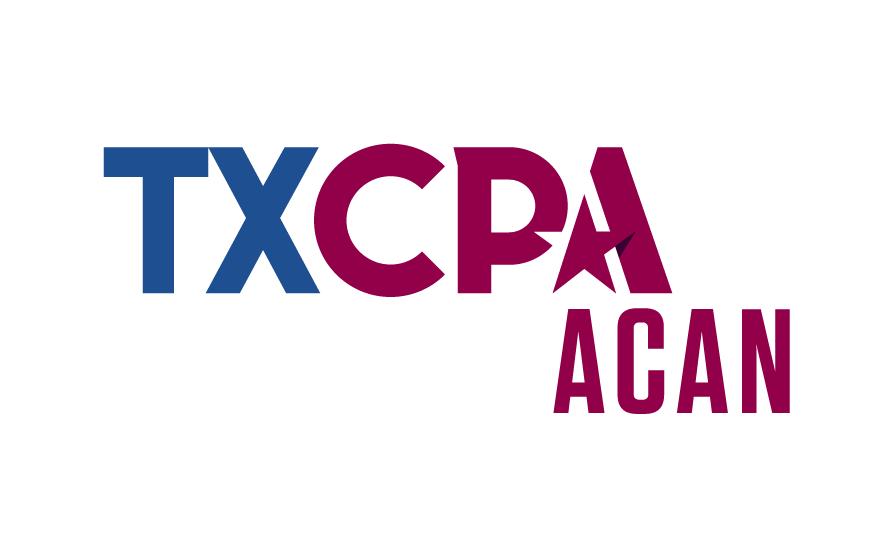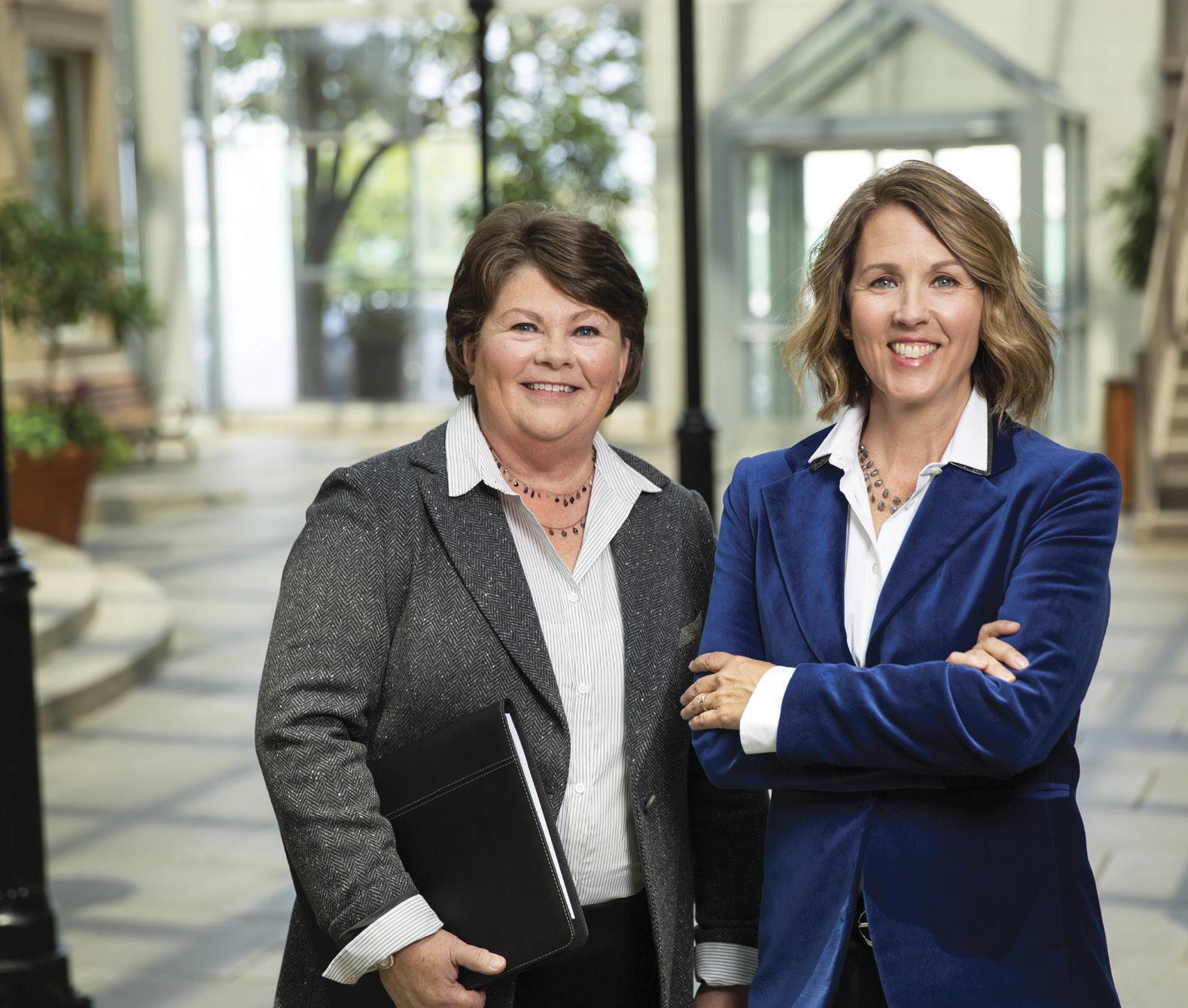
19 minute read
Take Note
MARK YOUR CALENDAR: TXCPA’s 2020 Annual Meeting of Members and Board of Directors Meeting June 26-27, 2020 at Worthington Renaissance Fort Worth Hotel, Fort Worth
Join us in Cowtown for learning, networking and fun! Click here
Save Time and Maximize Value With TXCPA’s Group Billing Program If you have more than one TXCPA member who works in your organization, you’re eligible for group billing benefits. Our convenient Group Billing Program allows renewal of all memberships within your organization at one time with a single dues invoice.
You’ll also receive other great benefits, including one free membership for a non-CPA firm administrator or office manager, reduced pricing for the TXCPA Passport, a 20% discount on select in-house CPE seminars, a complimentary 30-day job posting in the TXCPA Career Center, and more. Participation in the specially designed program ensures that your membership dues investment returns the highest value available.
Learn more about the benefits of the Group Billing Program on our website. Contact Stephanie King at sking@tscpa.net or 800-428- 0272, ext. 233 to enroll today!
Joe Guerra Receives 2020 B&I Award
TXCPA member Joe Guerra, CPASan Antonio, CGMA, was recently recognized with the 2020 B&I award! The award honors CPAs who work in general industry, government or education, and have made significant contributions through their influence and impact on others in the accounting profession.
Guerra is CFO of La Familia Cortez, the owners and operators of the Mi Tierra restaurants in San Antonio. Since their founding, the restaurants have become some of the most iconic establishments in San Antonio.
Guerra has been a member of TXCPA San Antonio for many years. He encourages all accountants and accounting students to pursue the CPA license. His chapter involvement includes serving on the B&I Committee, the Board of Directors and more. He brings energy and enthusiasm to all that he does and challenges the leadership of TXCPA San Antonio to think outside the box with respect to how the chapter Joe Guerra
approaches people, how to better serve members and potential members, and what kinds of new, creative CPE offerings can be offered.
TXCPA congratulates Guerra on being named as the 2020 B&I award recipient!
Stay Connected to TXCPA – Update Your Information Do you need to update your contact information, interest areas or other TXCPA preferences? Make sure you’re getting the most from your membership and don’t miss out on valuable resources by updating your information on our website. If you need assistance, please call member services at 800-428-0272 or 972-687-8500, option 1.

ACCOUNTANTS CONFIDENTIAL ASSISTANCE NETWORK The accounting profession is demanding of your TIME, ATTENTION & ENERGY It shouldn't take a toll on your MENTAL & PHYSICAL HEALTH


Ifyouarestrugglingwithalcoholaddiction,substanceabuseormental healthissues,ACANisheretohelp.ACANprovidesaconfidential conversationwithCPAvolunteerswhoha vefirst-handexperiencewith theseissues.ACANhelpsyoulearnhowtomergehealthierlivingwith yourdemandingaccountingcareer,andcanprovidereferralsto professionalswhoarefamiliarwithyouruniquechallenges.Don't hesitatetogetthehelpyouneedtoday.
ACANconvenesregularmeetingsofCPAs,examcandidates&accountingstudentsfor mutualsupport&opportunitiestoassistothers.Call orvisitusonlinetolearnmore.
Left: Ed Roth, CFA, CPA, CFP ® , CEBS • Charlotte M. Jungen, CPA, CFP ® • Wade D. Egmon, CPA, CFP ® • Steven R. Goodman, CPA, CFP ® • Chris A. Matlock, CPA, CFA

LET’s work ToGETHEr.
At Goodman Financial, we speak your language. While tax and accounting services are your specialty, we focus solely on financial advisory and investment management. As fee-only fiduciaries, we provide these services in a tax-efficient manner, in coordination with our clients’ CPAs. Our goal is to work with you in serving your clients.
This firm is not a CPA firm.
Call us today 713.599.1777 or visit www.GoodmanFinancial.com Serving clients across Texas and the US.
TXCPA’s Career Center – Connecting Employers and Qualified Candidates
Are you looking for an outstanding go-to place to find or post an employment position? Our online Career Center is for you! TXCPA makes this resource available to assist you in every phase of your career.
Job seekers can: View and apply for open positions, post their resumes, sign up for job alerts, get help with writing an effective resume, receive assistance from experienced career coaches, and more. TXCPA members can add a job seeker profile for free.

Employers can: Post their jobs online, manage applications, search resumes, set up an email resume alert, and more. TXCPA members receive exclusive savings on postings and can select options that provide enhanced visibility of their openings.
Check out theCAREER CENTER to learn more about the services available to find or post a job aimed specifically at accounting and finance professionals.
Distinguish yourself as a strategic leader.

Earn the global designation for financial professionals.
Explore the CGMA ®
Finance Leadership Program: It’s a lifelong professional learning journey that puts you on the path to take your career to a new level. You’ll learn and acquire the skills it takes to become a more strategic, confident, secure and insightful leader. Get started at CGMA.org/Program.
Brian Schwab, CPA, CGMA Global Account Finance Advisor, EY
© 2017 Association of International Certified Professional Accountants. All rights reserved. 23169D-326
TODAY’S CPA Texas Society of Certified Public Accountants



Start Building Stronger Business Relationships Today. 28,000 Members. Infinite Possibilities.


Today’s CPA provides companies with endless possibilities to grow their brands among key decision makers. Today’s CPA reaches 28,000 members across the state and includes an audience of partners, presidents, CEOs, executives, department managers, and additional professionals with buying power and authority for a range of products and services.

Today’s CPA is your best resource for reaching high-end purchasers and business advisors. All 20 local chapters and 28,000 TSCPA members throughout Texas receive Today’s CPA. These high-level and influential readers use the magazine as a resource to live up to the highest standards of ethics and practices within the CPA profession.
NONPROFIT ORGANIZATION GOVERNANCE, FINANCIAL METRICS AND TECHNOLOGY By Dr. Kamala Raghavan

Board members of nonprofit organizations are often confused by the differing reports about the financials and operating metrics by the finance and fundraising areas. The chief financial officer (CFO) is guided by the compliance and reporting rules, while the development director is guided by annual fundraising goals.
The development director may announce that a major donor pledge has helped to exceed the organization’s annual income goal, while the CFO refutes the claim and reports the organization’s annual income shortfall due to the conditional nature of the gift. The directors with governance responsibilities are confused and wonder who is right – the CFO or the development director. Both of the officials are right, because each is presenting his/her individual report based on his/her own view.
Finance and development each bring a unique but different perspective to an organization’s finances. For the finance team, Generally Accepted Accounting Principles (GAAP) rules established under Financial Accounting Standards Board (FASB) Statements No. 116 and No. 117 stipulate how gifts should be recorded and reported.
the general operating fund. Accounting and fundraising often use different databases and the reports leave the board members confused about the financial status of their organization.
So, what’s the answer? This article outlines the following basic steps to strengthen the governance process at nonprofit organizations:
• Education; • Collaboration; • Technology, including business process transformation; • Sustainability; and • Governance.
Nonprofit organizations are facing a new era where funders/donors see themselves as investors looking for proof of an organization’s effectiveness before they contribute. The organizations are dealing with a new definition of effectiveness going beyond the traditional measure of the percentage of administrative and fundraising overhead to revenues.
Education
The first step is education. Board members may be reluctant to go through extensive training in accounting and finance, but they must realize that they have a fiduciary responsibility to the organization.
Resources such as Board source, Nonprofits Assistance Fund and Nonprofit Finance Fund can help. Even a basic glossary of common terms can be helpful for both fundraisers and finance to understand how the various terms used about dollars raised can have different meanings to the audiences.
Collaboration
Another critical step towards mutual understanding is collaboration. When three blind men discuss what each of them felt by touching the elephant, they can put together a full picture of the elephant.
By collaborating ahead of time on how temporarily restricted contributions such as pledges and grants will be reported under accounting rules along with explanations on the differences, the board and executive leadership will be able to get a clear picture of the organization’s financial health.
Technology
Utilizing technology can help bridge the gap in communication and information reporting if business processes are carefully orchestrated using an integrated Enterprise Resource Platform (ERP) allowing the organization to automate many back-office functions and integrate fundraising software and accounting. Basic technology can accomplish three major tasks – data mapping and business process design, appropriate technology, and vision.
With data mapping and business process design, all involved parties need to agree on the data and operational level, synchronizing coding structures, and mapping multiple criteria to transactions. The chosen technology must be able to accommodate additional data and business processes, along with good change management strategies.
Vision must emanate from the nonprofit organization’s boards and executive leadership, and must consist of transparency, impact and stewardship of resources. The vision is based on the answer to these basic questions:
• What is the most meaningful aspect of the work that we do?
• How can stewardship and progress toward the goals be tracked and communicated? Results can be accomplished only by synchronized functionality between fundraising and finance teams, and by using technology to communicate a holistic picture of the organization.
Disruptive Technologies. The next step in technology development would be to review and identify the available disruptive technologies, such as predictive analytics, blockchain and artificial intelligence, while being cognizant of the need for robust cybersecurity practices to improve the organization’s effectiveness in the donors’ view.
The following disruptive technologies are rapidly changing the processes in the corporate sector of the economy, and donors and other stakeholders will also expect their adoption by the nonprofit sector.
Blockchain is a database that holds data and programs in heavily encrypted “blocks” of individual transactions as a result of executable files. The programs and codes can only be added and cannot be edited or deleted, with each block linked to the previous one, making a “blockchain.” It uses a digital ledger to share and track information related to contracts and transactions, and the records are permanent, verifiable and secure.
In summary, blockchain is a distributed database consisting of blocks of items that are timestamped, verifiable, permanent, and hashed and linked to other blocks. Blockchain is gaining adoption by governments and nonprofit organizations around the world.
Figure 1: What is Blockchain? Blockchain is a data structure that uses a distributed system of databases (ledgers). Every user is a “node” and has a copy of the ledger.
Nodes are connected by networks. All ledger records are visible to everyone, verified and cannot be changed once the transaction is done. Please also see Figure 2. Source: pWC Governance in the age of Blockchain, 2018
Predictive analytics bring together statistical analysis, data modeling and machine learning to observe trends and project into the future to help with judgements on likely outcomes. With predictive analytics, managers can adjust their resource capacity levels and types to future demands. They can transform “raw” transactional data into information to test hypotheses, analyze trends and make better decisions. Forward thinking nonprofits can use it to predict human resource levels, pricing, forecasting etc.
Figure 3: BudgIT and cMAPIT
BudgIT, a Nigerian startup and winner of Open Data Institute’s Social Impact Award, is promoting citizens’ understanding of government spending and budgets by providing the data in its portal. The increased transparency enables the fight against corruption in areas such as procurement, property ownership, etc.
cMAPIT, another Nigerian startup and winner of the Open Data Business Award, provides tools for citizens to track public policy and governance. It uses geospatial* data and drone technology to monitor public works projects, and it supports health and agriculture sectors. (*Geospatial data is data with an identifying geographic or locational component, such as latitude and longitude of a public building. It originates from the GPS data.) While pursuing the digital transformation, managers need to pay attention to implementing safeguards to protect the vast data stored in their systems from fraud and malicious interference. Some basic steps before getting started in data analytics are:
• Understand the data, identify anomalies and risk factors in the data, and identify new sources of data; • Recognize the relational and non-relational data; • Use multiple, synergistic tools, such as multivariate and inferential statistics, visualization tools, optimization, machine learning, and predictive analytics tools. • Use standard vendor-developed risk dashboards and filters to maximize efficiency, and use the regulatory and risk mapping view to map data and processes. • Based on the analysis, communicate the decisions and actions to add value to the citizenry.
Cybersecurity and Risk Management. Nonprofit organizations have been historically behind their corporate peers in reviewing and strengthening their cybersecurity and risk management practices. With the
Recalibrate funder expectations by providing accurate financial reports and other supporting information to reflect the true costs of operations to break the unhealthy cycle referred to as the "Nonprofit Starvation Cycle."

rapid acceleration of innovative technologies, they will have to step up their risk management framework.
New technologies bring their own risk issues, and organizations need to enhance their governance and validation processes to address the new technological risks without choking the benefits.
Sustainability
In their seminal article, “Nonprofit Starvation Cycle,” Ann Goggins Gregory and Dan Howard explain that the popular trend of restricting funding to specific programs without accounting for infrastructure expenses leads to an unintended consequence, a “nonprofit starvation cycle.” This is where charities cease to function because of their inability to pay for overhead costs, such as administrative employees, computers and electric bills. The article encourages nonprofits to recalibrate funder expectations by providing accurate financial reports and other supporting information to reflect the true costs of operations to break this unhealthy cycle.
Most nonprofit organizations try to consider sustainability, but do not consider the need for surpluses. Key performance metrics that include cash flow and
20 Texas Society of CPAs balance sheet reporting are critical in order to identify overall financial health of the organization. However, many organizations fail to consider the impact of a structural deficit (the gap between funds raised for a program or project, and costs to perform the tasks involved in implementation and maintenance) that can lead to collapse of long-term sustainability.
Governance
Managers and board members need to work together to identify financial, program and operational goals. Operations and finance teams will work from these goals to identify data elements, data entry, data storage and security.
Relevant reports and dashboards need to be created from the integrated enterprise resource systems. Performance metrics must efficiently ensure organizational health, program success and mission impact. Robust financial systems that consider and allocate direct and indirect costs across programs help executives make data-driven decisions about strategy, focus and program investments.
Nonprofit organizations should use both financial and non-financial metrics similar to the balanced scorecard
approach used by corporations. Financial, non-financial, talent, innovation and operations metrics must work cohesively to improve efficiency and effectiveness. Following are some of the financial and non-financial metrics that are commonly used.
Financial metrics: • Financial segment reports (operations, capital expenditures, special projects, etc.); • Staff roles and responsibilities; • Revenue (sources) and expense (uses) drivers using
Charity Navigator recommended scorecards and other metrics; • Commonly used nonprofit organization financial ratios; • Liquidity (can it pay current debts) = current assets (cash + A/R + inventory) / current liabilities; • Going concern (can it survive) = revenues / expenses; • Capital structure (reliance on debt) = (debt / total assets) and (debt / net assets); • Program effectiveness (expenses to accomplish its goals) = program expenses / total expenses; • Efficiency (expenses’ trend to achieve output) = program expenses / number of clients served; • Leverage and debt coverage (debt service expense
coverage relative to income = (revenue + support + gains + interest + depreciation) / annual debt expense; • fund raising efficiency = public support / fundraising expenses; • Investment performance (rate of total return on
investments) = (interest and dividends - gains/losses) / (average FV of investments)*; and • Average FV of investments = (beginning of year FV + end of year FV) / 2.
Innovation and operations metrics: • Customer satisfaction and/or complaints; • Customer response times; • Training for employees; • Improvement in system efficiencies; • Compliance reports and stewardship reports based on donor intent and transparency; and • Outcomes measurement.
Talent/HR metrics: Measurement of human resources falls into three broad areas – functional, operational and strategic measures.
Functional measures include employment efficiency, and effectiveness measures such as turnover, cost per hire and grievance numbers have traditionally been used. Sick leave (a useful proxy for staff dissatisfaction), outstanding annual leave (contingent liability), costs of employee disability insurance, expenditure on training and improvements in performance, staff turnover and recruitment costs are other commonly tracked and reported measures.
Operational measures to track productivity and profitability (revenue per employee, operating costs per work team) link talent management to organizational performance. Organizational effectiveness measures, combined with talent management, can include customer service measures like type of customer contact (in person/telephone/email) and call efficiency (abandoned service calls).
Possible metrics for return on investment (ROI) measures include:
• Success in the recruiting process; • The impact of an employment procedure; • Changes in an employee benefits package; and • The outcome of a diversity initiative, employee development program, suggestion program, etc.
Human resources functional areas are viewed as profit efficiency centers by allowing them to use “make or buy “analysis (buy services at best price from internal or external sources), making it important to have the program ROI measured and results disseminated to stakeholders.
Strategic measures are future oriented based on current skill base, culture, environment, technology and demographics. They match the current skill base against future needs by identifying and measuring intellectual capital to create the “knowledge management database” and align the human resources function with the organization’s strategic planning process. The above measures need to be based on the budgets and ongoing plans, and implemented with identifiable accountability measures.
Nonprofit Ratings and Reporting Guidelines
The watchdog agency Charity Navigator was founded in 2001 to evaluate nonprofit effectiveness similar to Consumer Reports. It has since become the largest and widely used evaluator of charities in the United States. Its professional analysts have developed a metricsbased rating system to evaluate nonprofit organization performance based on their review of tens of thousands of nonprofit organizations.
TXCPA’s Nonprofit Organizations Conference May 18-19, 2020


18 CPE Hours
This two-day program focuses on the specialized needs and challenges of nonprofit entities. You’ll learn more about economic and regulatory changes that impact your organization.
Click here for the details and to register for the 2020 Nonprofit Organizations Conference.

Charity Navigator’s rating system examines two broad areas of performance: • Financial Health and Accountability; and • Transparency.
Charity Navigator’s ratings demonstrate to donors how efficiently a nonprofit organization will use their contribution, how well funded its programs and services are, and its commitment to governance, best practices and transparency. Any nonprofit that receives a four-star rating from the agency is viewed as one with superior fiscal responsibility, signaling to potential donors its excellence in both information transparency and financial best practices. In the world of nonprofit fundraising, a four-star Charity Navigator rating is the most valuable and objective measure.
The Urban Institute and the Center for What Works have collaborated and developed a framework of common outcome indicators for the nonprofit sector, as well as a sample outcome monitoring chart and indicators for 14 program areas (www. Urban.org/nonprofits/index.cfm). Examples of program areas include adult education, family literacy, affordable housing, emergency shelter, performing arts, youth mentoring and others.
FASB Concepts Statement No. 4 also states that nonprofit organizations should provide information about service accomplishments as part of financial reporting. Service efforts and accomplishments can fall into four categories:
• Quantity of effort spent on the program (inputs); • Level of services provided (outputs); • Effect the service has on the program’s objectives (outcomes); and • Comparison of level of inputs with outputs or outcomes (efficiency).
Currently, most nonprofit organizations are accustomed to reporting inputs in financial terms, but output measures are expressed in non-financial terms, such as a homeless shelter reporting on the number of people housed, instead of a specific program. Outcome measures should express how well the program accomplished its goal, in view of external factors that could have had an impact on it.
Efficiency measures need to be well defined and developed, and provide information on how an organization achieves its program goals.
Staying Ahead of the Curve

Regardless of the performance metrics and presentation formats used, they will change as the processes mature. For example, completion of a project or meeting an expected outcome by the due date could be a good indicator in the early stages, but this evolves into other indicators like percent completion or average days completed ahead of the due date over the duration of the project.
Nonprofit organizations need to be aware and willing to change as needed, and they should tailor the program monitoring chart and outcome indicators based on their own mission. By measuring and drawing correlations between their programs and the outcomes, nonprofits will provide assurance to donors that their contributions are being used for the stated purposes both effectively and efficiently.
ABOUT THE AUTHOR: Dr. Kamala Raghavan is Professor of Accounting and Finance at Texas Southern University. Contact her at karaghavan@aol.com.
Kathy Brents, CPA, CBI Broker, Managing Member

Christy Hudson, CBI Broker
Selling your accounting firm is complex. Let us make it simple.
Contact Us
Office - 866.260.2793 Kathy Cell - 501.514.4928 Christy Cell - 501.499.4357
500 Amity Rd, Suite 5B-68 Conway, AR 72032
kathy@accountingbizbrokers.com christy@accountingbizbrokers.com accountingbizbrokers.com










